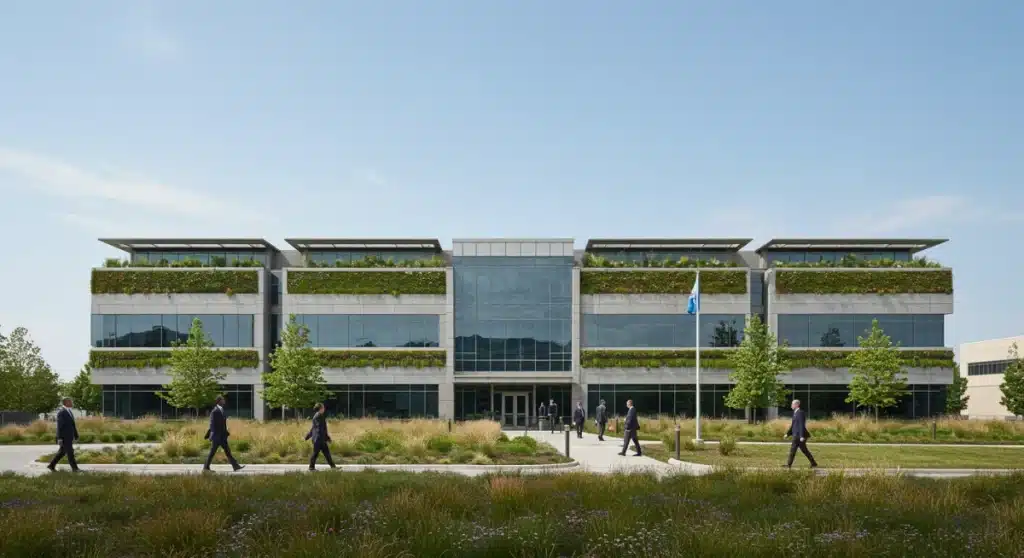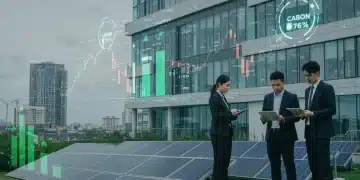Corporate Climate Resilience: A U.S. 5-Point Plan

Implementing a Corporate Climate Resilience U.S. 5-point plan is crucial for businesses to navigate escalating climate risks, ensuring operational continuity and long-term sustainability across various sectors.
As climate change accelerates, U.S. corporations face unprecedented challenges, from extreme weather events to supply chain disruptions. This step-by-step guide offers a practical framework for implementing a Corporate Climate Resilience U.S. 5-point plan, designed to enhance your business’s ability to withstand and adapt to these evolving environmental pressures. Understanding and acting on these strategies now is paramount for safeguarding assets and ensuring future prosperity.
Understanding the Imperative for Corporate Climate Resilience
The urgency for U.S. corporations to embrace climate resilience has never been clearer. Recent climate reports, including those from the National Oceanic and Atmospheric Administration (NOAA), highlight a dramatic increase in billion-dollar disaster events across the nation, impacting everything from agricultural yields to critical infrastructure. Businesses must move beyond mere compliance to proactive adaptation, integrating climate considerations into their core operational and strategic planning.
The Economic Toll of Inaction
The financial consequences of unaddressed climate risks are substantial. Companies that fail to prepare face potential losses from property damage, business interruption, increased insurance premiums, and diminished market confidence. Conversely, those that invest in resilience often find competitive advantages, including enhanced brand reputation and access to new markets focused on sustainable practices.
- Increased Operational Costs: Disruptions from climate events lead to unexpected expenses.
- Supply Chain Vulnerabilities: Interdependent global supply chains are highly susceptible to climate shocks.
- Regulatory Pressures: Evolving legislation demands greater climate accountability from corporations.
- Investor Scrutiny: Investors increasingly prioritize companies with robust climate resilience strategies.
These factors underscore a fundamental shift in the business landscape, where climate resilience is no longer an optional add-on but a strategic imperative. The U.S. government, through agencies like the Environmental Protection Agency (EPA), is also intensifying its focus on corporate climate preparedness, indicating a future with stricter environmental regulations and incentives for sustainable practices.
Point 1: Comprehensive Climate Risk Assessment and Identification
The foundational step in building Corporate Climate Resilience U.S. is conducting a thorough climate risk assessment. This involves identifying potential climate-related hazards, evaluating their likelihood and impact on business operations, and understanding the specific vulnerabilities within your organization and its value chain. This initial phase provides the critical data needed to inform subsequent resilience strategies.
Mapping Climate Hazards and Exposures
Begin by identifying the climate hazards relevant to your geographic locations and operational footprint. This includes physical risks like extreme heat, flooding, wildfires, and sea-level rise, as well as transitional risks such as policy changes, technological shifts, and market adjustments towards a low-carbon economy. Utilize data from credible sources like the IPCC, national climate assessments, and local meteorological services.
- Geographic Analysis: Pinpoint physical assets and critical operations in high-risk areas.
- Supply Chain Mapping: Identify climate vulnerabilities within your extended supply chain.
- Regulatory Scan: Understand current and anticipated climate-related regulations affecting your industry.
- Financial Impact Modeling: Quantify potential financial losses from various climate scenarios.
Once hazards are identified, assess your company’s exposure and sensitivity to each. This involves analyzing how different climate scenarios could affect your infrastructure, workforce, raw material sourcing, and customer base. A robust assessment considers both direct impacts, such as damage to facilities, and indirect impacts, like disruptions to transportation networks or utility services.
Point 2: Developing Adaptive Strategies and Operational Adjustments
With a clear understanding of climate risks, the next step is to develop and implement adaptive strategies. This involves making tangible operational adjustments to minimize vulnerabilities and enhance the business’s capacity to withstand and recover from climate-related events. These strategies should be integrated into existing business continuity and disaster recovery plans.
Integrating Resilience into Operations
Operational adjustments might include investing in resilient infrastructure, such as elevating critical equipment in flood-prone areas or reinforcing buildings against extreme winds. Diversifying supply chains to reduce reliance on single-source suppliers in vulnerable regions is another key strategy. Furthermore, adopting water-saving technologies, optimizing energy efficiency, and transitioning to renewable energy sources can significantly reduce both climate impact and operational risk.


Workforce preparedness is also crucial. Implementing training programs for employees on emergency response, remote work capabilities, and climate-aware decision-making strengthens overall resilience. This proactive approach not only protects employees but also maintains productivity during disruptions. The goal is to build a flexible and responsive operational framework that can quickly pivot in the face of climate challenges.
- Infrastructure Upgrades: Fortify physical assets against specific climate threats.
- Supply Chain Diversification: Reduce dependency and increase flexibility in sourcing.
- Resource Efficiency: Implement measures for water, energy, and material conservation.
- Employee Training: Equip staff with skills for climate-related emergencies and adaptation.
Point 3: Stakeholder Engagement and Collaborative Partnerships
Building comprehensive Corporate Climate Resilience U.S. extends beyond internal operations to include robust engagement with external stakeholders. Collaborating with suppliers, customers, local communities, and government entities creates a powerful network that can collectively address climate challenges. This point emphasizes the importance of shared responsibility and collective action.
Fostering Resilience Through Collaboration
Engaging with suppliers means working together to assess their climate risks and develop joint resilience strategies. This might involve setting shared sustainability goals, investing in resilient logistics, or even co-developing climate-resistant products. For customers, transparency about your climate resilience efforts can build trust and loyalty, fostering a shared sense of purpose.
Partnerships with local communities are vital, especially for businesses with significant local footprints. This can involve participating in local climate adaptation planning, contributing to community resilience projects, or offering resources during climate emergencies. Such engagement not only enhances your company’s social license to operate but also provides valuable local insights into climate vulnerabilities and solutions.
Government and Industry Alliances
Forming alliances with government bodies and industry associations can unlock access to critical resources, funding, and policy influence. These collaborations can help shape favorable regulatory environments, facilitate knowledge sharing, and support large-scale infrastructure projects necessary for regional resilience. Active participation in these networks ensures your company remains at the forefront of climate adaptation best practices and policy developments.
Point 4: Innovation and Technological Integration for Resilience
Innovation and the strategic integration of technology are pivotal accelerators for enhancing Corporate Climate Resilience U.S. This point focuses on leveraging cutting-edge solutions, from advanced data analytics to green technologies, to better predict, prepare for, and respond to climate impacts. Embracing innovation allows businesses to transform risks into opportunities for growth and efficiency.
Harnessing Data and AI for Predictive Resilience
Utilizing big data analytics and artificial intelligence (AI) can significantly improve the accuracy of climate risk assessments and the effectiveness of adaptive strategies. AI models can process vast amounts of climate data to forecast extreme weather events with greater precision, identify emerging vulnerabilities in supply chains, and optimize resource allocation for resilience measures. This predictive capability enables proactive decision-making rather than reactive responses.
- Climate Modeling Software: Tools for simulating future climate scenarios and their impacts.
- Sensor Networks: Real-time monitoring of environmental conditions affecting operations.
- AI-Driven Supply Chain Optimization: Algorithms to identify and reroute around climate-disrupted areas.
- Green Technology Adoption: Investing in renewable energy, carbon capture, and sustainable materials.
Beyond predictive tools, technological integration also includes deploying green technologies that directly contribute to resilience. This can range from installing solar panels and battery storage systems to ensure energy independence during grid failures, to implementing smart irrigation systems that conserve water during droughts. Investing in these innovations not only builds resilience but often leads to long-term cost savings and enhanced operational efficiency.
Point 5: Continuous Monitoring, Evaluation, and Adaptation
The final point in the Corporate Climate Resilience U.S. plan emphasizes that resilience is not a one-time project but an ongoing process. Continuous monitoring, regular evaluation of strategies, and a commitment to adaptive learning are essential to ensure that your business remains agile and effective in the face of evolving climate risks. This iterative approach allows for constant improvement and responsiveness.
Establishing Performance Metrics for Resilience
To effectively monitor progress, corporations must establish clear, measurable performance indicators for their climate resilience initiatives. These metrics could include reductions in carbon footprint, improvements in water efficiency, the percentage of resilient infrastructure implemented, or the speed of recovery from climate-related disruptions. Regular reporting on these metrics provides accountability and highlights areas for further action.
Periodic reviews and stress-testing of resilience plans are crucial. These exercises, similar to financial stress tests, simulate various climate scenarios to identify weaknesses in current strategies and inform necessary adjustments. Learning from both successes and failures, and incorporating new scientific understanding and technological advancements, ensures that the resilience plan remains dynamic and relevant.
- Regular Risk Audits: Periodically reassess climate risks and vulnerabilities.
- Scenario Planning: Conduct simulations to test the effectiveness of resilience strategies.
- Feedback Loops: Integrate lessons learned from climate events and new research.
- Adaptive Governance: Ensure leadership commitment to continuous improvement in resilience.
This continuous cycle of monitoring, evaluation, and adaptation ensures that your corporate climate resilience strategy is not static but evolves with the changing climate landscape and business environment. It reinforces the proactive and forward-thinking nature required for long-term sustainability and success.
| Key Point | Brief Description |
|---|---|
| Risk Assessment | Identify and evaluate climate hazards and their impacts on business operations and supply chains. |
| Adaptive Strategies | Implement operational changes and infrastructure upgrades to minimize vulnerabilities and enhance recovery. |
| Stakeholder Engagement | Collaborate with external parties like suppliers, communities, and government for collective resilience. |
| Continuous Adaptation | Monitor, evaluate, and regularly update resilience plans based on new data and evolving climate risks. |
Frequently Asked Questions About Corporate Climate Resilience
Corporate climate resilience is vital due to increasing extreme weather events, supply chain disruptions, and evolving regulations. It ensures business continuity, protects assets, and enhances long-term sustainability, offering a competitive edge in a changing economic landscape. Proactive measures mitigate financial and reputational risks effectively.
U.S. corporations face physical risks like floods, wildfires, and extreme temperatures, impacting infrastructure and operations. Transitional risks include policy changes, market shifts towards low-carbon economies, and technological disruptions. Both categories demand strategic adaptation to safeguard business interests and maintain profitability.
Technology, including AI and data analytics, enhances climate resilience by improving predictive modeling for extreme weather, optimizing resource management, and identifying supply chain vulnerabilities. Green technologies like renewable energy systems further reduce operational risks and carbon footprints, fostering sustainable and robust business models.
Stakeholders, including suppliers, customers, communities, and governments, are crucial. Collaboration fosters shared strategies, strengthens supply chains, and provides local insights into vulnerabilities. Engaging with these groups builds trust, enhances social license to operate, and unlocks collective resources for broader resilience initiatives.
Climate resilience is an ongoing, iterative process, not a one-time project. It requires continuous monitoring, regular evaluation, and adaptive adjustments based on new data, evolving climate science, and technological advancements. This dynamic approach ensures strategies remain effective and relevant in a constantly changing climate landscape.
What Happens Next
The implementation of a robust Corporate Climate Resilience U.S. plan is an ongoing journey that demands continuous attention. As of now, the latest climate science continues to project an increase in the frequency and intensity of extreme weather events, particularly across the U.S. Businesses that have initiated their resilience plans are already better positioned to navigate these challenges. We anticipate further regulatory developments at both federal and state levels, pushing for greater corporate accountability and incentivizing sustainable practices. Companies should closely monitor these policy shifts and integrate them into their evolving resilience frameworks, ensuring they remain compliant and competitive in a rapidly changing climate economy.





